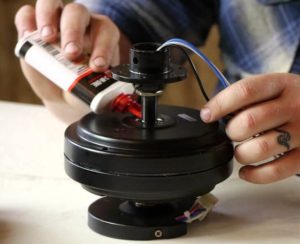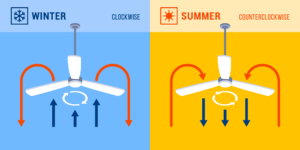Many modern ceiling fans can move in both directions. Many people are familiar with the direction which way their units should move in summer and winter, but there may be confusion when dealing with fall and spring since they are more of “transitional” seasons.
Below, we have discussed which direction to select when and why. I also tell how your fan can be beneficial regardless of the season!
Ceiling fan direction in fall and spring decides by the actual temperatures than the beginning of the season. Once there is a drop in temperatures in fall, the fan moves to run clockwise. When there is a rise in spring temperature, the fan’s settings on counterclockwise.
Why Change the Direction of the Ceiling Fan?
If you do not know about the reversible fans, you may get confused on what is the purpose of changing your fan’s direction.
In short, when your fan moves in one direction it results in an updraft, displacing warm air by the ceiling and circulating it in the surroundings.
The second direction causes a downdraft, which helps people to enjoy cooling with wind chill effect. This is the direction which is mainly used in ceiling fans and people are aware of it.
If your ceiling fan can move in both directions, it can be useful in colder season too by boosting your comfort; it does not only cool you in the summer season!
Use Ceiling Fans in Fall & Spring
Before we make a decision on which direction your ceiling fan should move, I would like to bring it to your attention that changing your fan’s direction is a great way to do the other maintenance of your fan!
It is usually suggested that you should remove the dust from your fans at least once every other month, and it can be difficult for you to clean something that you don’t really see.
This direction change can work as a reminder, you can make a full use of it by cleaning your fan twice a year. Some ceiling fans also need oiling, which may also require every year.
Which Way Should Ceiling Fans Turn in Spring?
For each season, I want to answer specifically, the main part is that weather and the climate could be entirely different when compared one place to another.
Some areas may have cool and rainy spring, and in some places, spring may be the part of summer season.
Having said that, as general suggestion, I would recommend keep the settings of your fan to summer mode or clockwise, as there is a high chance you will be facing warmer weather in spring.
Instead of keeping the direction of your fan entirely on seasons, you may want to change it according to the temperature. As discussed, climate can be different depending on your location or where you live on the planet.
In this case, you will definitely focus on once spring rolls around, but only you keep the settings on counterclockwise once the temperature starts to rise feeling warm whole day.
Let’s have a look at why you would want your fan to move in this manner in hot weather.
Reasons Why Should You Use Your Ceiling Fan in Spring
I have already mentioned to keep your fan counterclockwise as it is recommended for spring as well as for summer. I did not explain it properly why I said this.
The main reason of using your fan to run in a counterclockwise direction is that it causes a downdraft. In short, air is pushed down past you so you can have cooling, and causes a wind chill effect so you can experience the cooling.
A wind chill effect allows you to have cooling experience by pushing cooler air past your skin and also takes the heat away from your body. This effect also aids sweat to evaporate faster, and our body produces sweat to cool us down in a natural way.
In short, you should be familiar with it that fans don’t actually cool down a room.
To summarize, that is the main reason of using a fan – you will feel cooler! But people do not think that this is a secondary advantage.
If you spend most of your time in your bedroom under your fan, you can increase the thermostat several degrees higher than you normally would. You can save some bucks on your cooling experience by using a fan and it will do it. It helps you to save more or less 40% on your AC costs.
Furthermore, this decreases the stress on your air conditioner, which will improve its lifespan.
Which Way Should Ceiling Fans Rotate in Fall?
When dealing with spring, there is no final answer I can give everyone on which way their fan should move in fall.
There are some parts of the world where there is cool autumns, and the rest will bear the summer’s heat.
Generally, however, my suggestion is to keep your fan on winter or clockwise mode in the fall, assuming that you have a cooler weather.
Again, you may have to select the timing of your fan’s direction change as per temperature, not entirely depends on the beginning of the season. In this case, simply move your fan clockwise once you feel the weather has become consistently cool.
Let’s have a look why is this the ideal option.
Reasons Why You Should Use Your Ceiling Fan in Fall
When your fan moves clockwise, it moves in the opposite direction as well as perform opposite to when it moves counterclockwise. In short, clockwise fan rotation causes a updraft instead of downdraft.
The updraft sends the cooler air near the floor up towards the ceiling, spreading the warm air that is available at higher elevations.
The warm air is sent down through the sides of the walls as it is displaced so it reaches where you can experience it.
Again, whatever the direction is, your fan won’t change the temperature of the room. However, it can make your room warmer by dispersing the air is the main reason of using your fan in cold weather.
As ceiling fan can reduce your AC bills in summer, using your fan in a clockwise mode helps you to reduce the few degrees of thermostat than you normally use once cold temperatures occur. You can save money on heating, since you will not be able to sit in any cold pockets when your ceiling fan is ON.




